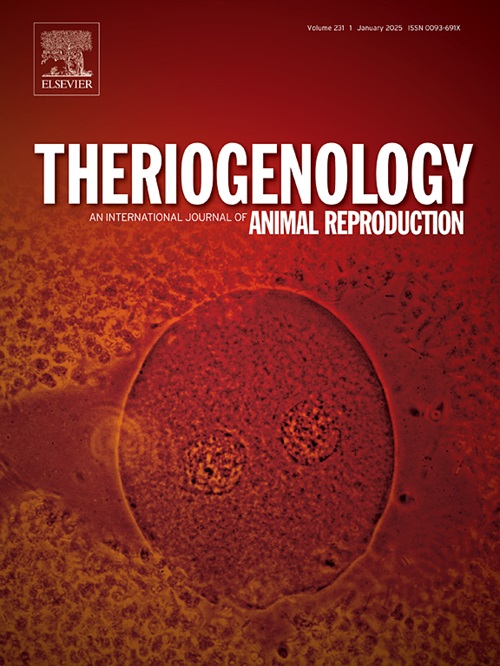通过 PCR 检测奶牛是否感染钩端螺旋体:检测的最佳样本是什么?
IF 2.5
2区 农林科学
Q3 REPRODUCTIVE BIOLOGY
引用次数: 0
摘要
牛钩端螺旋体病是一种主要的繁殖疾病。由于奶牛的肾脏和生殖道都可能是钩端螺旋体携带者,因此诊断具有挑战性,而且存在误诊的潜在风险。传统的诊断方法是对尿液样本进行培养或 PCR 检测。然而,最近有研究建议检测生殖器样本而非尿液,尤其是在诊断生殖器定植和生殖系统疾病时。本研究旨在比较尿液样本和生殖器样本,以检测在野外条件下自然感染且繁殖性能较差的奶牛中的钩端螺旋体携带者。研究选取了5个对Sejroe血清群血清反应性大于20%的牛群。对其中 106 头繁殖性能差的奶牛进行了研究,采集了尿液、子宫碎片(UF)和宫颈阴道粘液(CVM),并通过 lipL32-PCR 进行了检测。共有 73 头奶牛(68.9%)受到感染;其中 64 头(87.7%)通过阳性生殖器样本(UF 和/或 CVM)确诊,只有 14 头(19.2%)通过尿液确诊(p ≤ 0.001)。因此,如果研究仅限于尿液样本,则只有不到 20% 的受感染奶牛能被检测出来,这意味着该疾病被严重误诊,可能会影响控制计划的效果。在这种情况下,本研究强化了之前的发现,即检测生殖器样本,尤其是CVM,对于有效诊断受感染的亚发情奶牛至关重要。本文章由计算机程序翻译,如有差异,请以英文原文为准。
Detecting Leptospira spp. infection in cows by PCR: What is the best sample to test?
Bovine leptospirosis is a major reproductive disease. As cows can be leptospiral carriers both on the renal and genital tract, diagnosis can be challenging, with an underlying risk of misdiagnosis. Traditionally, the infection has been diagnosed by culturing or PCR from urine samples. Nevertheless, recent studies have suggested testing genital samples rather than urine, particularly for the diagnosis of genital colonization and reproductive disorders. The present study aimed to compare urine versus genital samples to detect leptospiral carriers in naturally infected cows with poor reproductive performance under field conditions. Five herds presenting >20 % of seroreactive animals against the Sejroe serogroup were selected. Of these, 106 cows with poor reproductive performance were studied, and urine, uterine fragment (UF), and cervicovaginal mucus (CVM) were obtained and tested by lipL32-PCR. A total of 73 (68.9 %) cows were infected; 64 of which (87.7 %) were diagnosed via positive genital samples (UF and/or CVM), while only 14 (19.2 %) by urine (p ≤ 0.001). Therefore, if the study had been limited to urine samples, as largely recommended, less than 20 % of the infected cows would have been detected, representing a huge misdiagnosis of the disease that could undermine the efficacy of control programs. In this context, the present study reinforces prior findings that testing genital samples, particularly CVM, is crucial to effectively diagnosing infected subfertile cows.
求助全文
通过发布文献求助,成功后即可免费获取论文全文。
去求助
来源期刊

Theriogenology
农林科学-生殖生物学
CiteScore
5.50
自引率
14.30%
发文量
387
审稿时长
72 days
期刊介绍:
Theriogenology provides an international forum for researchers, clinicians, and industry professionals in animal reproductive biology. This acclaimed journal publishes articles on a wide range of topics in reproductive and developmental biology, of domestic mammal, avian, and aquatic species as well as wild species which are the object of veterinary care in research or conservation programs.
 求助内容:
求助内容: 应助结果提醒方式:
应助结果提醒方式:


